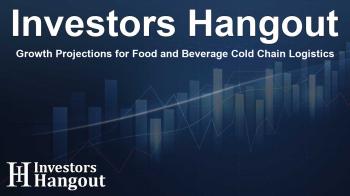Growth Projections for Food and Beverage Cold Chain Logistics

Market Growth and Future Outlook
The food and beverage cold chain logistics market is experiencing remarkable growth, anticipated to surge from USD 90.81 billion in the coming year to an astounding USD 219.44 billion by a specified future date. This translates into a compelling compound annual growth rate (CAGR) of 10.3% during the forecast period. Such growth is propelled by an increasing global demand for fresh and frozen foods.
Key Drivers Behind Market Expansion
Factors fueling this rapid expansion include the high demand for frozen foods and the rise of e-commerce platforms, which facilitate convenient access to a variety of food products. The ever-increasing number of food service outlets is further driving the necessity for efficient food storage solutions, thus impacting the logistics sector positively.
Adapting to Consumer Expectations
The current market landscape reflects a pronounced shift in consumer behaviors, with a growing tendency towards fresh and frozen food consumption. This trend is particularly marked among younger demographics, including the emerging Gen Z population, whose preferences are reshaping the industry.
Innovative Technologies Leading the Charge
The integration of advanced technologies within the cold chain logistics paradigm is essential. Innovations like real-time monitoring systems and predictive maintenance have transformed operational efficiencies, thereby minimizing waste and enhancing compliance with strict food safety regulations.
Market Overview: Trends and Insights
The manipulation of the food and beverage cold chain logistics market is evident with the advent of sustainable practices. The industry is evolving towards utilizing lower global warming potential (GWP) refrigerants and solar-powered warehouses, part of the broader initiative to achieve environmental goals.
Catalysts for Change
A major shift is apparent as artificial intelligence (AI) plays a transformative role in the logistics market. AI technologies bolster efficiency by providing real-time data, enabling businesses to manage conditions such as temperature and humidity throughout the supply chain, thereby ensuring product safety. This technology underpins features like predictive analytics which assist in foreseeing potential equipment failures before they disrupt operations.
Environmental Sustainability Initiatives
The overarching trend in cold chain logistics is toward sustainability. This involves efforts to adopt systems that reduce energy consumption while maintaining product integrity. The search for eco-friendly alternatives is reshaping operational frameworks within the industry.
Addressing Regulatory Challenges
Alongside operational costs, the industry grapples with regulatory requirements that can impose additional challenges. The establishment of temperature-controlled warehouses, crucial for product safety, significantly drives up operational expenses. The successful navigation of these challenges will dictate future profitability and market viability.
Market Stratification and Analysis
The sector is segmented based on various criteria including application, with fruits, vegetables, and beverages leading the pack. The meat and seafood segment is expected to grow as consumer demand increases for safe, properly stored products.
Regional Trends and Growth Potential
North America is currently the largest market player, largely due to its developed infrastructure and technological advancements. However, the Asia Pacific region is projected to witness the most rapid growth, driven by rising disposable incomes and an increasing appetite for diverse food products.
Future Opportunities and Recommendations
The future holds significant potential for smart logistics solutions. Embracing innovations such as IoT-enabled systems and smart packaging will enhance operational effectiveness and reduce food wastage.
Frequently Asked Questions
What factors are driving growth in the food and beverage cold chain logistics market?
The significant growth is driven by increased demand for fresh and frozen foods, advancements in technology, and the rise of e-commerce platforms.
What technological innovations are transforming the market?
Innovations include real-time monitoring systems, AI integration for predictive maintenance, and sustainable refrigeration methods.
How are sustainability initiatives shaping the cold chain logistics landscape?
There is a strong focus on reducing environmental impact through the adoption of energy-efficient practices and use of eco-friendly refrigerants.
Which regions are seeing the most growth?
North America currently dominates the market, but the Asia Pacific region is expected to grow the fastest due to increased consumer spending.
What challenges does the industry face?
High operational costs for maintaining temperature-controlled facilities and navigating complex regulatory requirements can hinder growth.
About The Author
Contact Dylan Bailey privately here. Or send an email with ATTN: Dylan Bailey as the subject to contact@investorshangout.com.
About Investors Hangout
Investors Hangout is a leading online stock forum for financial discussion and learning, offering a wide range of free tools and resources. It draws in traders of all levels, who exchange market knowledge, investigate trading tactics, and keep an eye on industry developments in real time. Featuring financial articles, stock message boards, quotes, charts, company profiles, and live news updates. Through cooperative learning and a wealth of informational resources, it helps users from novices creating their first portfolios to experts honing their techniques. Join Investors Hangout today: https://investorshangout.com/
The content of this article is based on factual, publicly available information and does not represent legal, financial, or investment advice. Investors Hangout does not offer financial advice, and the author is not a licensed financial advisor. Consult a qualified advisor before making any financial or investment decisions based on this article. This article should not be considered advice to purchase, sell, or hold any securities or other investments. If any of the material provided here is inaccurate, please contact us for corrections.

